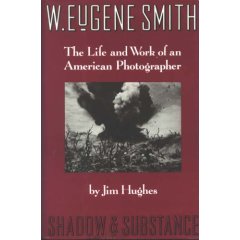W. Eugene Smith is one of my heroes.
He is one of Jim Hughes’ passions.
Hughes is the author of W.Eugene Smith, Shadow and Substance.
He sent me the following email, in response to my analogies between Leicas and Smith’s work.
I always want to make sure I get it right.
Now, it is:
 Michael: While I agree in general with your comments about Gene Smith and
the photographic essay (and somewhere in my Smith biography I do comment on
his influence on future film and video essayists), I must dispute a few of
your purported facts. First, the Country Doctor essay (1948) preceded the
Welsh miner photographs (1950) by some two years. More importantly, I found
no evidence that Gene favored Leicas during WWII. Before the war, Zeiss had
had a strong U.S. presence, and Gene liked their high-speed optics. He
purchased Contax equipment early on, after which time both Zeiss and Leitz
were hard to obtain. A story in the June 1944 issue of Popular Photography
by John Whiting detailed the equipment he carried to that time: two Zeiss
Ikoflexes, a Rolleiflex, a 4×5 Graflex, two Speed Graphics (one for color,
one for aerial work) a 35mm Contax with five lenses and a Kodak Medalist.
See page 121 of my book. A year or so later, having left Ziff-Davis for
Life, he was severely injured on Okinawa. His life was saved by the Super
Ikonta B he had to his eye (the final frame, which survived, showed the
explosion); this is the camera that took the brunt of some shrapnel at the
instant he stood up to photograph his subject, infantryman Terry Moore, whom
he had been assigned to follow for 24 hours. Also damaged, the ever-present
Contax that had been hanging around his neck. See page 172 of my book.He began to use Leicas extensively, but not exclusively, after his recovery
from his injuries, when he started to photograph regularly for Life, where
the Leica, in production and available again, was favored by many staffers.
His photographs in England and Spain seemed to be fairly evenly split
between 35mm and 2 1/4, although it was in Spain that the Leica began to
predominate, and it was those pictures that defined his poetic vision.If you have information to the contrary about any of this, I’d be grateful
to know about it. Thanks.Best,
Jim Hughes
